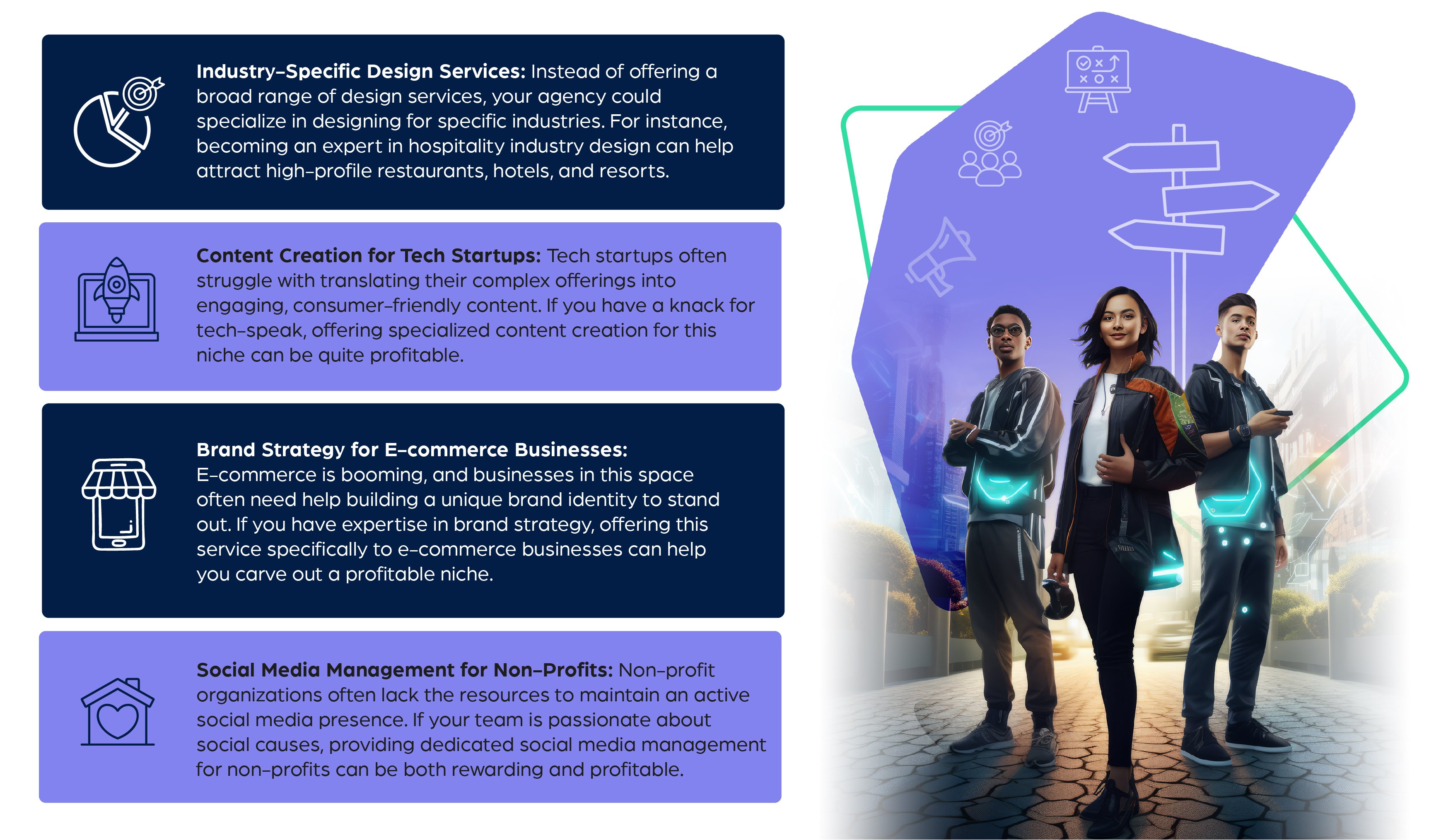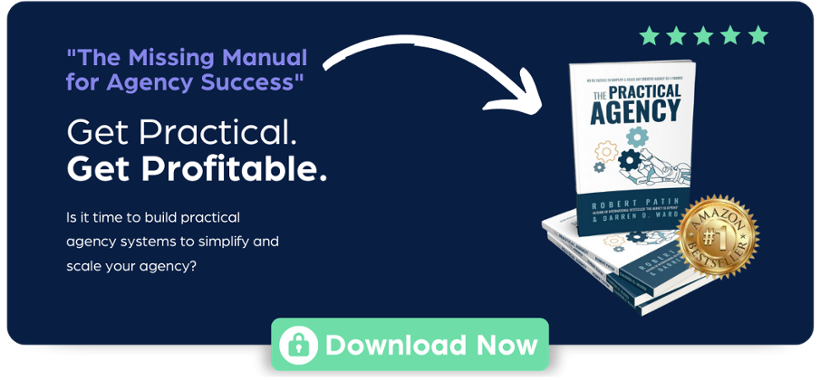Scale or Fail: The 3 Factors That Will Make or Break Your Creative Agency

Picture this:
You're up late (again), drowning in project timelines, client demands, and the constant pressure of making ends meet. The creative fuel that once drove your passion has been diluted by the never-ending flood of tasks and the stress of a dwindling bank account.
Does this sound like a typical weekday night for you these days?
Unfortunately, this is the vicious cycle many creative agency owners find themselves stuck in thanks to an unsustainable business model. If this sounds like your current reality, it’s time for a change. To ensure your agency is set up to experience growth and sustainability, it’s essential to recognize which services are profitable to scale, and what is holding you back.
Thankfully, there is no guesswork or luck involved in successfully scaling a creative agency. All you need is the right roadmap to help you stay on track.
The Profitable Path of Specialization

In the early stages of your creative agency, you’re in startup mode. Eager to generate some revenue to get off the ground, chances are you signed any and every client you could. However, as you navigate through the complexities of business growth, the "all clients are welcome" model can quickly become unsustainable.
For the same reason you wouldn’t seek out a dermatologist if you needed heart surgery, dialling in on a specific clientele to specialize your services is the key to scaling your agency’s revenue (and ultimately your financial freedom). Specializing allows you to concentrate your resources, streamline your processes, and establish your brand as a leading expert in a particular field (a move that inevitably attracts high-quality, higher-paying clients).
Not sure what specializing your creative agency’s service offering looks like? Check out these examples:
- Industry-Specific Design Services: Instead of offering a broad range of design services, your agency could specialize in designing for specific industries. For instance, becoming an expert in hospitality industry design can help attract high-profile restaurants, hotels, and resorts.
- Content Creation for Tech Startups: Tech startups often struggle with translating their complex offerings into engaging, consumer-friendly content. If you have a knack for tech-speak, offering specialized content creation for this niche can be quite profitable.
- Brand Strategy for E-commerce Businesses: E-commerce is booming, and businesses in this space often need help building a unique brand identity to stand out. If you have expertise in brand strategy, offering this service specifically to e-commerce businesses can help you carve out a profitable niche.
- Social Media Management for Non-Profits: Non-profit organizations often lack the resources to maintain an active social media presence. If your team is passionate about social causes, providing dedicated social media management for non-profits can be both rewarding and profitable.
There's a common misconception that providing a wide range of services attracts more clients. But in reality, clients will be more inclined to work with someone who can provide precise solutions to their specific problems. By narrowing your focus, you’ll naturally start to attract a concentrated pool of ideal clients—those who value your specialty and are willing to pay for it. This enables you to charge more for your expertise and stop wasting time with more dead-end leads.
For example, say your creative agency started by offering general graphic design services, from logo creation to brochure design, and you’re stretched thin over numerous small projects with limited profitability. As you spend time getting to know the market, you notice a demand for high-quality, specialized food packaging design, and your team has the skills and passion to deliver it.
By honing your focus on this food packaging niche, you attract food businesses ready and willing to hire expert packaging designers at a premium for your specialized service. Not only that, but you’ve become such experts at solving the same, specific problem, your team can produce winning results twice as fast.
Now, your agency's profitability increases even though you're servicing fewer clients, and your business becomes more efficient and scalable.
Scaling With The Right Pricing Model
Even if you have successfully honed in on the perfect niche for your agency, there is still one important piece to the scalability puzzle: your pricing model.
Uncovering which services are profitable to scale necessitates reassessing your pricing strategy. Pricing is more than just a dollar amount—it’s a strategy that directly impacts your scalability and profitability. If you're investing countless hours on projects but your revenue doesn’t reflect this effort, your pricing strategy is likely to blame.
Creative agencies typically follow one of the following common pricing models:
- Hourly Rate: Clients pay based on the amount of time spent on their project. While it is considered the most straightforward pricing model, it can limit your scalability as your revenue is tied directly to the number of billable hours you can work.
- Fixed Rate: Here, you charge a set fee for a specific service or project. It offers predictability for both you and your client. On the downside, it can lead to profitability issues if a project requires more time or resources than initially estimated.
- Retainer Model: With this model, clients pay a monthly fee for a set amount of work. It provides predictable income and fosters long-term client relationships. However, it can sometimes limit your ability to take on new clients or projects due to ongoing commitments.
- Value-Based Pricing: This model involves setting prices based on the perceived value of the service to the client. It allows for higher profit margins and communicates the value of your work. The challenge lies in accurately determining and demonstrating that value.
- Performance-Based Pricing: Under this model, your payment is tied to the results you deliver. It can be lucrative if you're confident in your ability to deliver results. However, it bears the risk of non-payment if the agreed-upon results aren't achieved.
The most common pricing models in creative agencies are hourly rates and project-based fees. While these may have served your business initially, they can inhibit your ability to scale as they’re limited by time and capacity.
Instead, consider the value-based recurring revenue model, where you can price your services based on the value they provide to the client, rather than punishing your agency’s ability to complete a good job quickly.
It offers the opportunity for recurring revenue via long-term contracts or retainers, securing a steady cash flow and enabling better forecasting and planning. Clients appreciate it, too, as they benefit from a partnership focused on delivering value, rather than watching the clock.
For example, instead of charging by the hour for social media services, your agency could offer a monthly package that includes a set number of posts, audience engagement, and analytics reporting. You know that this will ultimately generate more leads (and subsequently more revenue) for your client, so instead of just selling time; you're selling a solution and the value it delivers to your client's business.
The Efficiency of Productized Services
Moving away from custom packages to productized services is the next powerful step toward scaling your agency. While customization might seem client-centric, it often leads to inefficiencies, inconsistency, and scope creep, all of which can hinder scalability.
Productizing involves packaging your services into standardized offerings with set prices, clearly defined deliverables, and timelines. This makes it easier for clients to understand, value, and buy your services. Moreover, it makes it easier for your team to execute, enhancing productivity and efficiency.
Productization doesn't limit your creativity; instead, it provides a consistent framework within which you can deliver unique and valuable outcomes. Clients know exactly what they're getting, which enhances trust and satisfaction. You're selling a predictable experience, a promise of value that's easier to sell, deliver, and scale.
For example, instead of offering custom services for every new client you encounter, consider offering tiered packages instead. Each package provides a clearly defined scope of work at a set price, with the flexibility to add on additional services as needed. This clarity streamlines client decisions, enhances your team’s workflow, and improves your agency's scalability.
Are your current clients or services are impeding your agency's scalability?
Not sure whether your current services or clients are holding back your agency's ability to scale? To help you make good, profitable decisions moving forward, use these handy techniques to help evaluate your current scenario and set the wheels of change in motion:
- Service Profitability Analysis: Review all the services you offer. How much time, resources, and effort do they require? How much revenue do they generate? This exercise will help you identify low-margin services that drain your resources and high-margin ones that boost your profitability. Consider phasing out less profitable services and focusing on the ones that offer a better return on investment.
- Client Profitability Analysis: Not all clients are created equal. Some require more hand-holding and have a higher cost of service, while others are low-maintenance and more profitable. Identify which clients generate the most revenue and which demand more time and resources. This will help you understand the types of clients you should be targeting to improve profitability.
- Demand and Market Analysis: Are your services in high demand? Is there a niche market you could tap into that aligns with your expertise? Conducting a market analysis can help you identify opportunities for specialization and understand where the greatest potential for profit lies.
- Pricing Evaluation: If you're constantly negotiating prices or dealing with scope creep, it's a clear sign your pricing strategy needs a revamp. Evaluate whether your prices reflect the value you provide and if your pricing model supports your scalability objectives.
- Service Delivery Assessment: Analyze how you deliver your services. Is there a lot of custom work, or could you package your services into standardized offerings? Productizing your services can greatly enhance scalability and profitability.
By assessing your services and clients using this checklist, you can make more informed, profitable decisions and pave the way toward a more scalable, successful creative agency.
Say hello to financial freedom
Pinpointing which services to scale is the catalyst in transforming your agency from a time-consuming, low-margin venture into a streamlined, profitable business. Specializing your offerings, choosing a scalable pricing model, and productizing your services are the vital steps toward a more successful and sustainable agency.
Scaling your creative agency involves not just growing bigger but growing smarter, implementing systems that empower you to work on your business, not just in it. To dive deeper into the journey of scaling your creative agency, visit creativeagencysuccess.com for a wealth of resources tailored to your needs.
Your creative agency is a reflection of your passion and talent. It's time to ensure it grows profitably and sustainably and reflects the freedom and financial success you envisioned at its inception.









